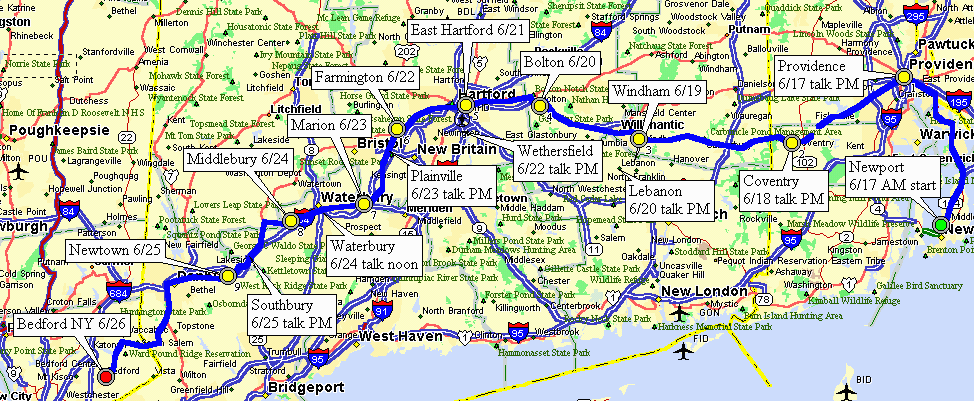Wednesday, June 23
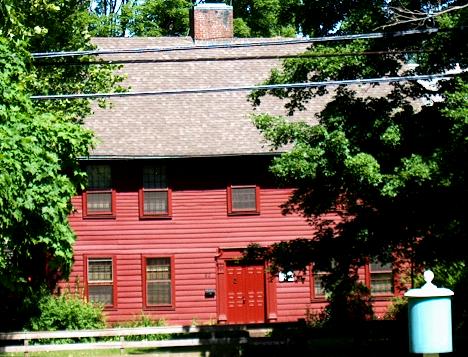
The day started in Farmington. As we drove along Main Street (Route 10)
-- the route taken by Rochmbeau's army -- we enjoyed seeing many
Revolutionary-era homes that have been carefully preserved and restored.
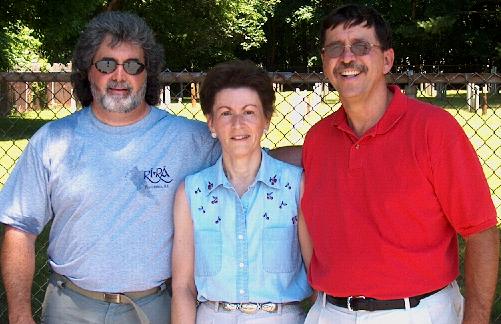
In Plainville we met representatives of the local press and
several hikers who wanted to accompany Lee today. They pointed
out a path along the river that led to the French campsite south
of Farmington and set off.
Unfortunately for Lee's feet, the path ended after two miles
due to lack of regular trimming, so they had to push
through meadows with six-foot grass, then ford a fifty-foot wide
stream. After a trek of eight miles they returned to the van.
While they walked the trail I stopped to visit the Farmington
Congregational Church (founded in 1652). The present building
was built in 1771 and is three-stories tall, not counting the steeple.
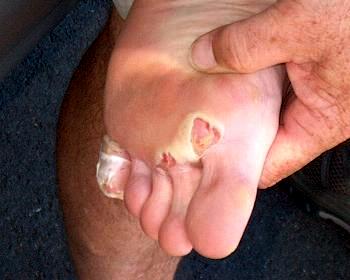
The miles, shoes, and socks were hard on Lee's feet.
Several blisters formed and broke, requiring medication.
Lee added an extra shock-adsorbing pad inside his shoes
to reduce the pounding his toe joints were getting from
hiking on asphalt. While this and gel pads on the blisters
helped, the condition of his feet remained a matter of concern.
Lee ended this day's walk in Plainville.
The roads near Hartford cross several large rivers and boggy areas
in only a few places, so we had to drive twenty miles on the
Interstate to circle around a tangled network of local roads
to get from Wethersfield (where we are staying for three days)
to Farmington and then back on this evening.
Because of all the side trips to get supplies, see historic sights,
get to presentations, and get to our motels the van travelled
about eight times as far as Lee walked (not counting driving up
from Delaware).
=== TOP OF PAGE===
Thursday, June 24
After checking the route from Plainville through Marion to
Waterbury we joined Ken Buckbee (president of the Conecticut Society SAR)
and Albin Weber (re-enactor) at the Pierpont Cemetery, which contains
a monument honoring the two unknown French soldiers (from Rochambeau's army)
who are buried there.
Ken wore a frontiersman uniform; Albin wore a Continental uniform.
Also present was Homer Lantier, a resident of Connecticut
and a member of the Branch Francaise of the SAR.
His ancestor was one of Rochambeau's troops.
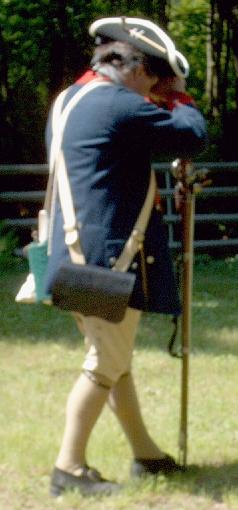
Albin Weber performed the traditional ceremony of grief and respect
for the dead by firing a single musket shot and taking a barrel-down pose.
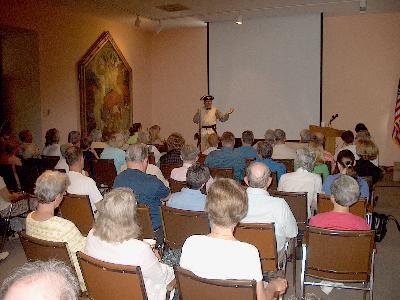
Lee and the re-enactors then marched (with a police escort) three and
a half miles to the Mattatuck Museum in Waterbury, where we spoke to an audience
of about seventy people. Ken and Albin provided additional
comments about the local effort to commemorate the W3R. Lee than walked
to Breakneck Hill, where we picked him up to explore by car the route to Southbury.
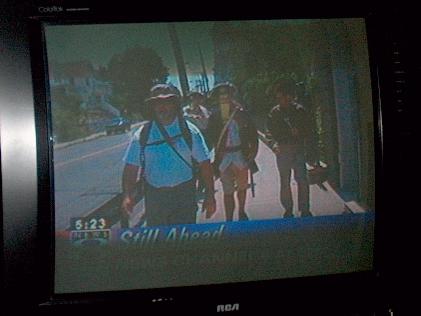
A TV crew from Channel 8 videotaped the march, as well as
our vidoegrapher from Rhode Island, who drove to Waterbury to get
additional footage of Lee's walk. The event made the 5 o'clock
news, including brief comments from Lee, Albin, Ken, and
several bystanders.
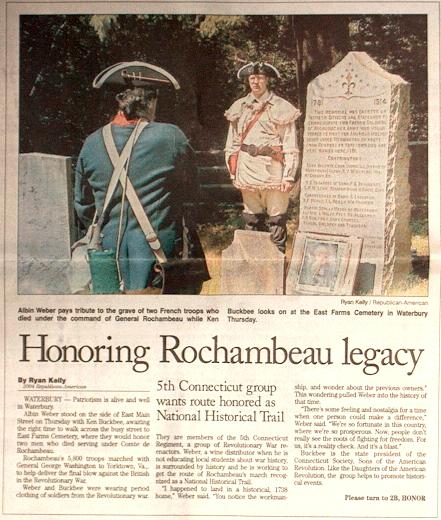
An article by Ryan Kelly in the Republican American (Waterbury CT)
helped publicize information about the historic events and the development
of the W3R as a historic trail to a much wider audience than we reached
in the lectures. The photographers were drawn to men in uniform, so although Lee
was the focus of the article, the photo is of the local re-enactors
-- who do the important work of educating the public over a period
of several years, while we could provide a highlight event for only one day.
=== TOP OF PAGE===
Friday, June 25
Albin Weber took us on a tour of the old roadways and possible
campsites of the French army around Southbury. Lee and I then did more
exploring on our own. One of Lee's tasks is to make on-the-spot observations
to help the historians decide which of several proposed campsites or roadways
is most likely to have been the one used by the allied forces.
To do this he must envision what the landscape would have been like 223 years ago.
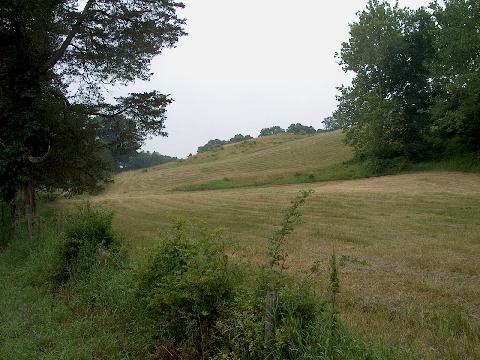
It was cleared farmland then, not the second-growth forest one often sees there now.
Many swamps that blocked travel then have been drained or filled in,
and rocky outcroppings have been blasted away or buried to make a level area,
so what may seem an obvious route today was impossible for wagons
to get through during the Revolution.
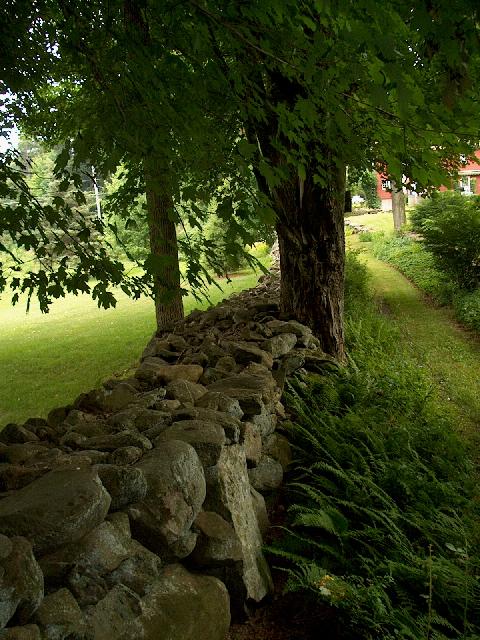
In 1781 the rocks removed from the fields were often piled up
as thick stone walls along both sides of a road. The roadways were
too narrow for a modern auto route, and they were hard to dismantle,
so many early asphalt roads were laid out along another route,
thus the old road was not destroyed. Eighty years later the local residents
may not know that the "new" road with the old name is not the original route.
We believe that this was the case for Breakneck Hill in Middlebury.
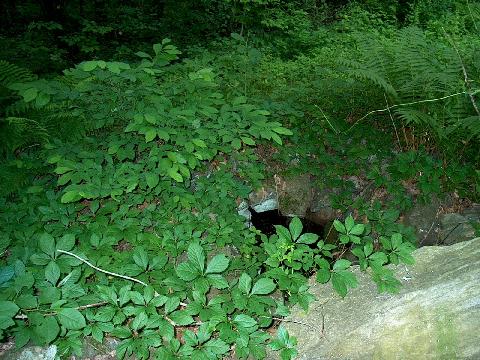
As we walked on the original (we believe) roadway we found
a small arched bridge that allows a spring rivulet to run under
the road rather than making a muddy mess of the road.
We hope historians can answer the question "Was this bridge built
by the French road crew that preceded the army so that the baggage train
would not get bogged down in the mud here?
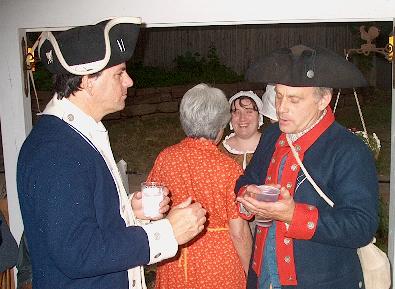
Dinner with the Weber family was followed by a reception with local historians,
at which the re-enactors of the 5th Connecticut Regiment gave a demonstration
of volley fire.
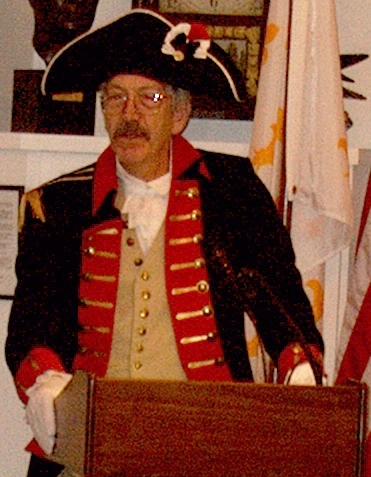
We gave our presentation in uniform -- but without our video slide show
-- to an auduence of about seventy people. This is Ralph in uniform and
a moustache grown specifically for presentations along the route of march.
Saturday, June 26
Due to the condition of Lee's feet and his non-W3R schedule we drove home
(to NJ and then DE) early in the morning rather than walking into New York.
We reviewed the route from Southbury CT to the Bedford NY area from the
van window -- much more forested now than it was then,
but clearly quite hilly and hard to march through.
In 1781 the road probably have twisted and turned a lot to provide
a gentle grade, since otherwise double teams (slowing the journey)
would have been required to pull the baggage wagons up the many steep hills.
In summary, we had a fine time following the route and meeting many enthusiastic
supporters of the W3R, and we made presentations about the W3R to hundreds of people
(and through TV and papers we informed thousands more). It was good to get home,
where we continued to work on plans for the next three legs of the trip.
| 